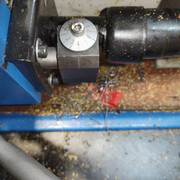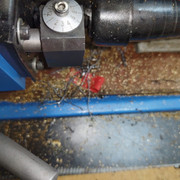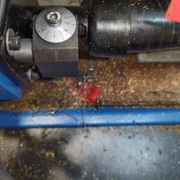By the way, when threading, instead using the falf nut, Can I reverse the direction of the rotation right?
Yes. In fact, that's one of the ways to cut metric threads on an imperial machine. The threading dial doesn't work for that, so the most straightforward way to do it is to stop the motor, back the cutter out with the cross slide and put the motor into reverse
without disengaging the half nuts. The lead screw and change gears have enough backlash that you can't leave the cutter in the threads when going in reverse -- you will mangle the threads you just cut. So at the start of each pass you have to advance the cross slide back to its "zero" position (set when you started cutting the threads), then advance the compound to actually cut the threads.
The above method is easier if you cut a runout groove so you don't inadvertently crash the cutter into an un-threaded part of your work. I usually stop a bit short and finish each pass by hand-turning the chuck. A lot less drama that way, especially while cutting coarser threads -- the carriage can move awfully fast when doing that!
Many lathe owners don't power-thread at all, they attach a handwheel to the spindle and turn the chuck by hand. There are a bunch of designs out there for one of those.
There is another way to do it that does allow you to disengage the half nuts but you have to keep track of the position of the threading dial so when you re-engage the half nuts (while running the lathe in reverse) they drop into the same exact relationship to the lead screw they had when cutting the threads. Joe Pi has a videa regarding that method. I haven't tried that method yet.
Finally, with the right toolholder you can cut the threads in reverse so the cutter naturally moves away from the work. The cutter has to be upside-down. You can't use a toolholder designed to cut from the front, it has to be one that raises the tool back up to the spindle centerline. I'm not aware of one that is commercially available for mini lathes so you'd have to make one.
If you're cutting any nonstandard threads (say, for a differential screw) you also will need to employ one of these cutting methods.





